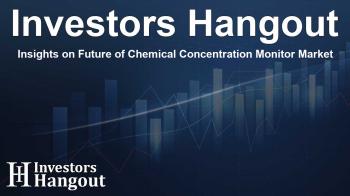Insights on Future of Chemical Concentration Monitor Market

Future Growth of the Chemical Concentration Monitor Market
The chemical concentration monitor market is on an impressive trajectory, projected to grow significantly and reach approximately USD 9.36 billion by 2030. This growth represents a notable increase from an estimated USD 6.90 billion in 2025, showcasing a compound annual growth rate (CAGR) of 6.3% over the forecast period. The expansion of this market is largely influenced by notable trends such as the rising demand for real-time chemical analysis, an increase in process automation adoption, and a heightened emphasis on product quality, safety, and environmental compliance.
Key Factors Driving Market Expansion
Several driving forces are pushing the growth of the chemical concentration monitor market. Increased applications in varied sectors—including chemical processing, pharmaceuticals, semiconductors, food and beverages, and water treatment—are enhancing the demand for reliable monitoring systems. The ongoing advancements in technologies such as optical and ultrasonic sensing, coupled with the integration of IoT monitoring solutions and AI-driven process analytics, are significantly boosting measurement accuracy and operational efficiency. These improvements are vital for industries striving to transition to automated and intelligent industrial monitoring systems globally.
Technological Advances Shaping the Industry
Among the impressive technological advancements, optical methods are emerging as a frontrunner, projected to exhibit the highest CAGR during the forecast period. Their superiority in accuracy, non-contact operations, and ability to provide real-time, continuous measurements set them apart. Technologies like infrared (IR), near-infrared (NIR), UV-Vis, and Raman spectroscopy offer high sensitivity and precision, making them essential in detecting chemical compositions across multiple media, particularly in pharmaceuticals and chemicals.
Understanding Product Segmentation
The market's segmentation sheds light on various facets of adoption and innovation. The amperometric ion sensor segment is anticipated to account for the largest revenue share during the forecast period. This is attributable to its high sensitivity and rapid response, coupled with broad applicability across diverse industrial processes. These sensors excel in real-time monitoring, especially in industries such as water treatment and pharmaceuticals, where precise concentration control is critical.
Regional Insights and Dominance
Regionally, the Asia Pacific is expected to assume a dominant position in the global chemical concentration monitor market during the forecast period. Its strong industrial base, fast-paced technological advancements, and significant investments into process automation across various sectors, including chemicals and pharmaceuticals, make it a vital area for market growth. Initiatives aimed at promoting industrial safety and sustainable manufacturing practices are further propelling this region's market leadership.
Challenges and Opportunities Ahead
Despite the strong growth prospects, certain challenges remain, particularly concerning the integration of new technologies with existing legacy systems. However, this challenge opens avenues for innovation, especially as companies explore expansion into emerging markets and decentralized treatment systems. The focus on improving environmental monitoring and quality control presents unique opportunities within this evolving market landscape.
Industry Players Shaping the Market
Several key players are influencing the dynamics of the chemical concentration monitor market, employing diverse strategies for growth. Companies like Thermo Fisher Scientific Inc., Emerson Electric Co., ABB Ltd., and Endress+Hauser Group Services AG are leveraging product launches and strategic partnerships to enhance their market presence. Their efforts in innovation and growth initiatives ensure they remain competitive and relevant in this expanding sector.
Frequently Asked Questions
What is the projected market size of the chemical concentration monitor market?
The market is projected to reach approximately USD 9.36 billion by 2030, up from USD 6.90 billion in 2025.
What technology segment will exhibit high growth in this market?
The optical technology segment is expected to register the highest CAGR due to its accuracy and real-time measurement capabilities.
Which region is anticipated to dominate the market?
The Asia Pacific region is projected to dominate the market, driven by robust industrial growth and technological advancements.
What are key challenges faced by the market?
Integration challenges with legacy infrastructure pose a significant obstacle for the adoption of new concentration monitoring technologies.
Who are the major players in the chemical concentration monitor market?
Key players include Thermo Fisher Scientific Inc., Emerson Electric Co., ABB Ltd., and Endress+Hauser Group Services AG.
About The Author
Contact Thomas Cooper privately here. Or send an email with ATTN: Thomas Cooper as the subject to contact@investorshangout.com.
About Investors Hangout
Investors Hangout is a leading online stock forum for financial discussion and learning, offering a wide range of free tools and resources. It draws in traders of all levels, who exchange market knowledge, investigate trading tactics, and keep an eye on industry developments in real time. Featuring financial articles, stock message boards, quotes, charts, company profiles, and live news updates. Through cooperative learning and a wealth of informational resources, it helps users from novices creating their first portfolios to experts honing their techniques. Join Investors Hangout today: https://investorshangout.com/
The content of this article is based on factual, publicly available information and does not represent legal, financial, or investment advice. Investors Hangout does not offer financial advice, and the author is not a licensed financial advisor. Consult a qualified advisor before making any financial or investment decisions based on this article. This article should not be considered advice to purchase, sell, or hold any securities or other investments. If any of the material provided here is inaccurate, please contact us for corrections.

